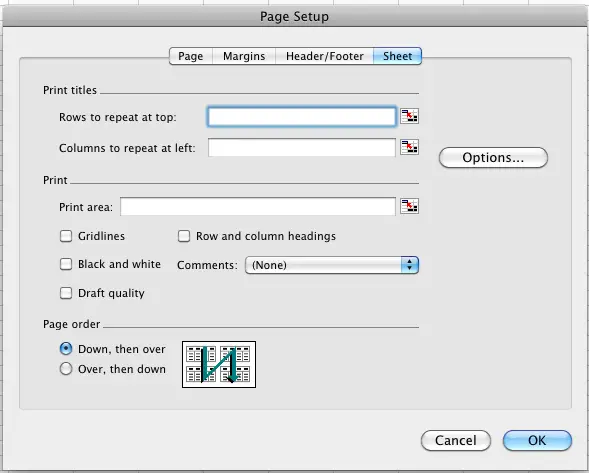

Reset Print Area - Same as (File > Print Area > Clear Print Area)Īny manual page breaks stay fixed when you make changes to the Page Setup, Page tab, Adjust to %Ĭhanges to fit to - temporarily removes any manual page breaks (although switching back to "Adjust to" brings them back again). Set Print Area - Same as (File > Print Area > Set Print Area) Reset All Page Breaks - Removes any manual page breaks. Remove Page Break - Only appears when you select a cell (or range) that is below or to the left of a page break (excluding the outside border). Insert Page Break - Inserts a manual page break above the selected row to the left of the selected column.

There is also some additional commands on the Cell shortcut menu when you are in Page Break Preview. Select the row directly below or the column directly to the right of the page break. To remove all the page breaks, select the whole worksheet and select (Insert > Remove Page Break). To remove a vertical page break move the mouse over a cell in the column directly to the right of the page break line and select (Insert > Remove Page Break). To remove a horizontal page break move the mouse over a cell directly below the page break line and select (Insert > Remove Page Break) To add a Horizontal page break, select the row below the row you want as the last row on the page It is possible to insert both Horizontal as well as Vertical page breaks. These are darker than automatic page breaks

Manual page breaks appear as bold dashed lines on the screen. To insert a manual page break, select the row or column you want to appear at the beginning of the new page and select (Insert > Page Break).Īny manual page breaks that you insert will over-write any that Excel placed fro you automatically. You can remove a print area by selecting (File > Print Area > Clear Print Area). The select (File > Print) and make sure the "Selection" is checked in the Print What options. If not then the entire worksheet is printed. If you have then this range of cells is printed. If you change the "Print What" option buttons to Active sheet(s) then Excel will automatically check if you have a named range called "Print_Area" defined on those worksheets. This will create a named range "Print_Area" automatically that will be used when printing. To only print part of a worksheet highlight the cells you want to print and select (File > Print Area > Set Area). The dashed lines are the default breaks that Excel inserts automatically. The solid lines are breaks that you have manually inserted. If they are moved they are displayed as solid lines (because they then become manual breaks) It is possible to also drag the print boundaries to include more or fewer columns or rows in your print area.ĭotted lines show where automatic breaks will occur You can drag the blue page breaks with your mouse to customise the printable area. You can adjust the page breaks in several ways. It is just an alternative way to look at your worksheet. It is possible to make other worksheet changes while working in this view, such as changing content, increasing column widths, removing rows etc. To view these automatic page breaks select (Tools > Options)(View tab, Page Breaks). When you have finished you can select (View > Normal).Įxcel will insert page breaks for you automatically. The White area denotes the area that will be printed.ĭefining a Print Area lets you restrict the cell range that is printed.

This lets you see the print area clearly with all the page breaks identified. You can see the range of cells that will be printed by selecting (View > Page Break Preview). The Print Area is the area or range of cells that will be printed.Ī page break defines where one page ends and another one begins.


 0 kommentar(er)
0 kommentar(er)
